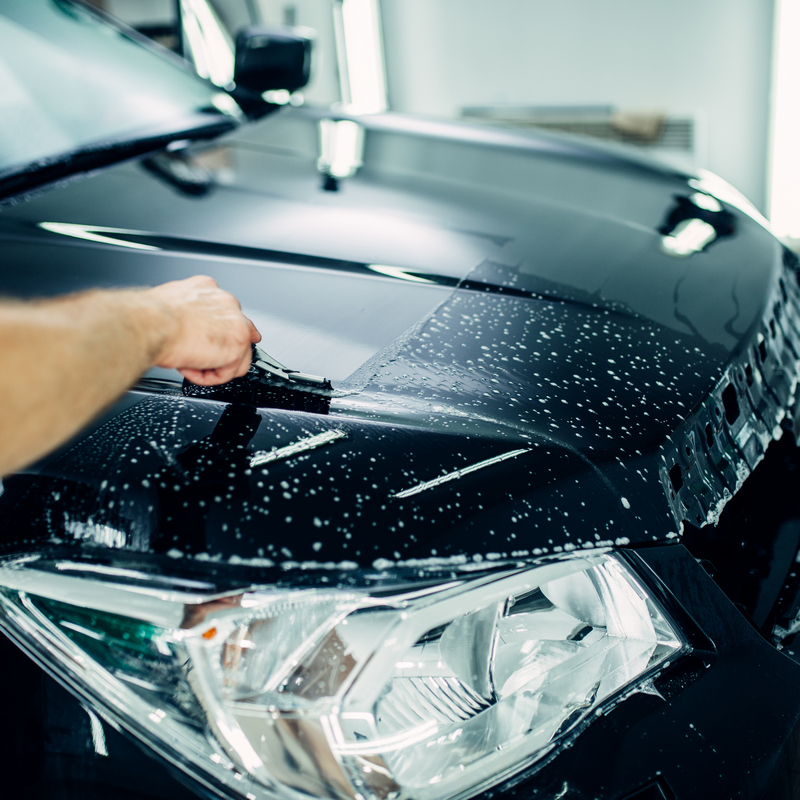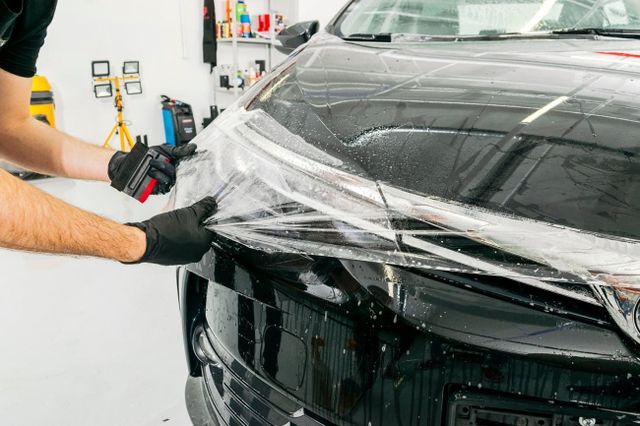Everything About Paint Protection Film: Comprehending Its Essential Role in Vehicle Treatment
Paint Protection Film (PPF) has ended up being a necessary facet of car treatment over the last few years. This transparent guard serves to protect a car's outside from usual dangers such as scratches and environmental damage. Comprehending the auto mechanics behind PPF and its various benefits is important for lorry proprietors. Lots of remain not aware of the various types readily available and the installation procedure entailed. What factors should one take into consideration before using PPF to their automobile?

What Is Paint Protection Film?
Paint protection film (PPF) is a clear, sturdy layer made to secure an automobile's paint from damage. This advanced material, usually made from polyurethane, is crafted to resist scrapes, chips, and contaminants, ensuring the car maintains its visual charm with time. PPF can be used to numerous surfaces, consisting of the hood, fenders, and bumpers, providing targeted protection where it is most needed.The film is not only resistant to use and tear yet also provides a self-healing building; minor scrapes can vanish with direct exposure to heat. In addition, PPF works with numerous vehicle finishes and can be tailored when it come to density and gloss degrees. Its application has become progressively prominent amongst auto lovers and day-to-day vehicle drivers alike, as it maintains the car's worth and look. By buying paint protection film, owners can delight in an excellent exterior while lessening maintenance initiatives.
Just How Does Paint Protection Film Work?
Paint protection film functions by creating a sturdy obstacle that safeguards surfaces from square one and other physical damages. In addition, it gives protecting against damaging UV rays, which can discolor and deteriorate paint with time. Lots of contemporary films likewise incorporate self-healing modern technology, allowing small abrasions to vanish with warmth direct exposure.
Protection From Scratches
Shielding a car's exterior from the ground up is a vital issue for lots of proprietors, and paint protection film (PPF) uses a reputable option. This clear, thermoplastic urethane film is developed to adhere to the car's surface area, developing an obstacle that takes in impacts from roadway debris, branches, and other possible threats. The film's elasticity enables it to stretch and comply with various forms, making it ideal for various lorry designs. SpeedEFX Clear bra Centennial. Furthermore, PPF is self-healing; small scratches can vanish with warm exposure, keeping the automobile's appearance. By acting as a durable shield, paint protection film properly lowers the danger of unpleasant acnes, protecting the visual integrity and resale worth of the vehicle for years ahead
UV Ray Protecting
An automobile's outside faces multiple risks, including harmful UV rays that can fade paint and deteriorate surfaces gradually. Paint protection film (PPF) works as an awesome obstacle against these harmful ultraviolet rays. Made from advanced polymer products, PPF obstructs a substantial portion of UV radiation, stopping it from penetrating the lorry's clear coat and paint layers. This shielding effect not only protects the car's shade and finish but likewise prolongs the life expectancy of the paint. By efficiently absorbing and reflecting UV radiation, paint protection film minimizes the risk of oxidation and staining. Lorry proprietors who spend in PPF can take pleasure in improved visual appeals and raised resale value, understanding their vehicle is secured against the unfavorable effects of sunlight direct exposure.
Self-Healing Modern technology

Advantages of Paint Protection Film
Paint Protection Film (PPF) offers countless benefits for vehicle proprietors looking for to maintain their automobile's appearance and worth. Among the primary advantages is its ability to protect the lorry's paint from square one, chips, and environmental impurities. This layer of protection assists preserve the factory finish, avoiding costly repainting or describing. Additionally, PPF is immune to UV rays, which can trigger fading over time, therefore keeping the vehicle's visual appeal.Another considerable advantage is the film's self-healing buildings; small scrapes can vanish with heat direct exposure, making sure the vehicle remains visually immaculate. PPF is also simple to keep, calling for just normal cleaning to keep it looking fresh. Using paint protection film can boost resale worth by demonstrating that the car has been well cared for. Overall, PPF is a wise financial investment for those dedicated to protecting their automobile's problem and prolonging its life expectancy.
Various Types of Paint Protection Film
Different kinds of Paint Protection Film (PPF) satisfy various needs and preferences among vehicle proprietors. Clear bra films are among one of the most popular choices, offering a clear layer that safeguards the automobile's paint without modifying its appearance. These films are ideal for those who desire to maintain the more info original appearance of their auto while guarding it from scratches and roadway debris.Another kind is self-healing film, which includes a distinct polymer that can fix small scrapes and swirl marks when revealed to warmth. This kind provides enhanced long life and visual charm. Furthermore, colored PPF is available for those wanting to personalize the appearance of their vehicle, permitting for a distinct coating while still offering protection.Lastly, textured films are developed for details surfaces, such as matte finishes, ensuring that the safety qualities do not endanger the vehicle's layout. Each sort of PPF serves unique functions, boosting both protection and customization.
Installation Process for Paint Protection Film
The setup process for paint protection film starts with meticulous surface area preparation to assure ideal adhesion. This includes cleaning, brightening, and potentially dealing with the vehicle's paint to eliminate any kind of flaws. Adhering to prep work, different application strategies are utilized to successfully apply the film without bubbles or folds.
Surface Area Prep Work Steps
Before using paint protection film, precise surface preparation is vital to guarantee suitable adhesion and durability of the film. This process begins with a comprehensive cleansing of the automobile's surface to get rid of dust, crud, and contaminants. A top quality automotive soap ought to be made use of, complied with by rinsing and drying with a microfiber towel to protect against scratches. Next, any existing wax or sealers need to be removed, typically making use of an isopropyl alcohol option to assure a completely bare surface. Inspecting for blemishes such as scratches or swirl marks is essential, as these can affect the film's look and efficiency. Mindful masking of nearby areas helps shield them during the installation procedure, ensuring a clean and accurate application.
Application Techniques Explained
Grasping the application strategies for paint protection film is vital for accomplishing a perfect surface. The installment process begins with mindful placement of the film on the automobile's surface, guaranteeing exact positioning over the intended area. As soon as positioned, a solution of water and soap is commonly utilized to help with repositioning and bubble removal. Smooth, regulated pressure is used utilizing a squeegee, beginning from the center and working outward to get rid of air pockets. Warmth may be used with a heat gun to improve attachment and aid in contouring around curves and edges. After reducing excess film, the edges are sealed to avoid training. Appropriate strategy and attention to information throughout installation ultimately improve the film's resilience and visual charm.
Maintenance and Take Care Of Paint Protection Film
Proper maintenance and treatment are essential for making sure the long life and performance of paint protection film. Routine cleansing is essential; it is advised to wash the automobile with a pH-balanced, non-abrasive soap to stop any kind of damages to the film. Making use of soft microfiber towels for drying out will assist prevent scratches.Avoiding automated vehicle washes with brushes is recommended, as these can raise the edges of the film. In addition, it is necessary to promptly remove contaminants such as bird droppings, tree sap, and roadway tar, as they can deteriorate the film over time.For suitable protection, waxing the film every few months can boost its sparkle and sturdiness, yet treatment should be required to utilize waxes that are secure for clear films. Routine assessments for any indicators of training or gurgling must also be performed, enabling prompt repair work to maintain the stability of the protection.
Often Asked Inquiries
The Length Of Time Does Paint Protection Film Typically Last?
The long life of paint protection film generally varies in between five to 10 years. Elements affecting its life expectancy include environmental problems, maintenance practices, and the top quality of the film applied, affecting general performance in securing the car's surface.
Can Paint Protection Film Be Eliminated Without Damaging the Paint?
Removing paint protection film can be done safely, normally without harming the underlying paint. However, successful removal depends upon the film's age, application technique, and the surface condition, requiring mindful technique to assure paint honesty.
Is Paint Protection Film Visible Once Set Up?
When mounted appropriately, paint protection film is developed to be almost unseen. SpeedEFX Clear bra Centennial. Nevertheless, some people might observe a mild sheen or appearance distinction, depending upon the vehicle's paint and the film's high quality
Does Paint Protection Film Protect Against UV Rays?
The question of whether paint protection film secures versus UV rays develops frequently. This film is developed to protect the lorry's paint from damaging ultraviolet radiation, aiding keep the automobile's look over time.
Will Paint Protection Film Affect My Automobile's Resale Value?
The influence of paint protection film on an automobile's resale value can be positive, as it maintains the paint's condition. Prospective buyers may have varying viewpoints regarding its visibility, affecting total bankability and viewed worth.